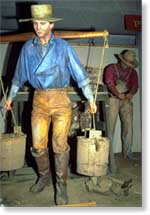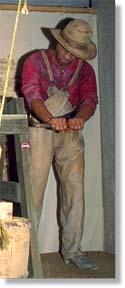  
Prospecting - Coyote Hole

Click icon to hear
Coyote Hole Miner
 The
Coyote Hole was named after the den of these common animals. Miners were trying to reach
the ancient, buried river channels that held rich deposits. The shafts were as deep as 100
feet. Working inside the hole was the most dangerous type of gold mining, with frequent
cave-ins. The gravel, dirt and gold hauled up by windlass, were then carried to a nearby
stream for washing. Imagine the task when you're down there. You only have room for a
small pick to break through the hard-packed dirt, clay and rocks. It was observed that:
These coyote diggings require to be very rich to pay, from the great amount of labor
necessary before any pay dirt can be obtained. Accidents frequently occur from the
'caving-in' of these diggings. The
Coyote Hole was named after the den of these common animals. Miners were trying to reach
the ancient, buried river channels that held rich deposits. The shafts were as deep as 100
feet. Working inside the hole was the most dangerous type of gold mining, with frequent
cave-ins. The gravel, dirt and gold hauled up by windlass, were then carried to a nearby
stream for washing. Imagine the task when you're down there. You only have room for a
small pick to break through the hard-packed dirt, clay and rocks. It was observed that:
These coyote diggings require to be very rich to pay, from the great amount of labor
necessary before any pay dirt can be obtained. Accidents frequently occur from the
'caving-in' of these diggings.
What Price Freedom?
One of the miners
here is an African American. Many were brought to California as slaves, even though
California entered the Union as a free state.
On the mines the
Americans seemed to exhibit more tolerance of Negro blood than is usual in the States -
not that Negroes were allowed to sit at table with white men, or considered to be at all
on an equality. - anon.
 Many
African Americans came to California during the gold rush, and some bought something very
special for their families with the gold they found - their freedom. William Swain noted
in his diary: There are Negroes here laboring for their liberty. On the Louisiana claim
one is to pay $120,000 for himself, [and his] wife and child, and yet he is a free man
here. His wife, like the wives of others, is held as a pledge of good faith. Many
African Americans came to California during the gold rush, and some bought something very
special for their families with the gold they found - their freedom. William Swain noted
in his diary: There are Negroes here laboring for their liberty. On the Louisiana claim
one is to pay $120,000 for himself, [and his] wife and child, and yet he is a free man
here. His wife, like the wives of others, is held as a pledge of good faith.
Top: Coyote Hole, Photo by Christopher Richard
Chinese Camp | Arrastra | Miwok Mining Site | Coyote Hole | Long Tom |


 The
Coyote Hole was named after the den of these common animals. Miners were trying to reach
the ancient, buried river channels that held rich deposits. The shafts were as deep as 100
feet. Working inside the hole was the most dangerous type of gold mining, with frequent
cave-ins. The gravel, dirt and gold hauled up by windlass, were then carried to a nearby
stream for washing. Imagine the task when you're down there. You only have room for a
small pick to break through the hard-packed dirt, clay and rocks. It was observed that:
These coyote diggings require to be very rich to pay, from the great amount of labor
necessary before any pay dirt can be obtained. Accidents frequently occur from the
'caving-in' of these diggings.
The
Coyote Hole was named after the den of these common animals. Miners were trying to reach
the ancient, buried river channels that held rich deposits. The shafts were as deep as 100
feet. Working inside the hole was the most dangerous type of gold mining, with frequent
cave-ins. The gravel, dirt and gold hauled up by windlass, were then carried to a nearby
stream for washing. Imagine the task when you're down there. You only have room for a
small pick to break through the hard-packed dirt, clay and rocks. It was observed that:
These coyote diggings require to be very rich to pay, from the great amount of labor
necessary before any pay dirt can be obtained. Accidents frequently occur from the
'caving-in' of these diggings. Many
African Americans came to California during the gold rush, and some bought something very
special for their families with the gold they found - their freedom. William Swain noted
in his diary: There are Negroes here laboring for their liberty. On the Louisiana claim
one is to pay $120,000 for himself, [and his] wife and child, and yet he is a free man
here. His wife, like the wives of others, is held as a pledge of good faith.
Many
African Americans came to California during the gold rush, and some bought something very
special for their families with the gold they found - their freedom. William Swain noted
in his diary: There are Negroes here laboring for their liberty. On the Louisiana claim
one is to pay $120,000 for himself, [and his] wife and child, and yet he is a free man
here. His wife, like the wives of others, is held as a pledge of good faith.